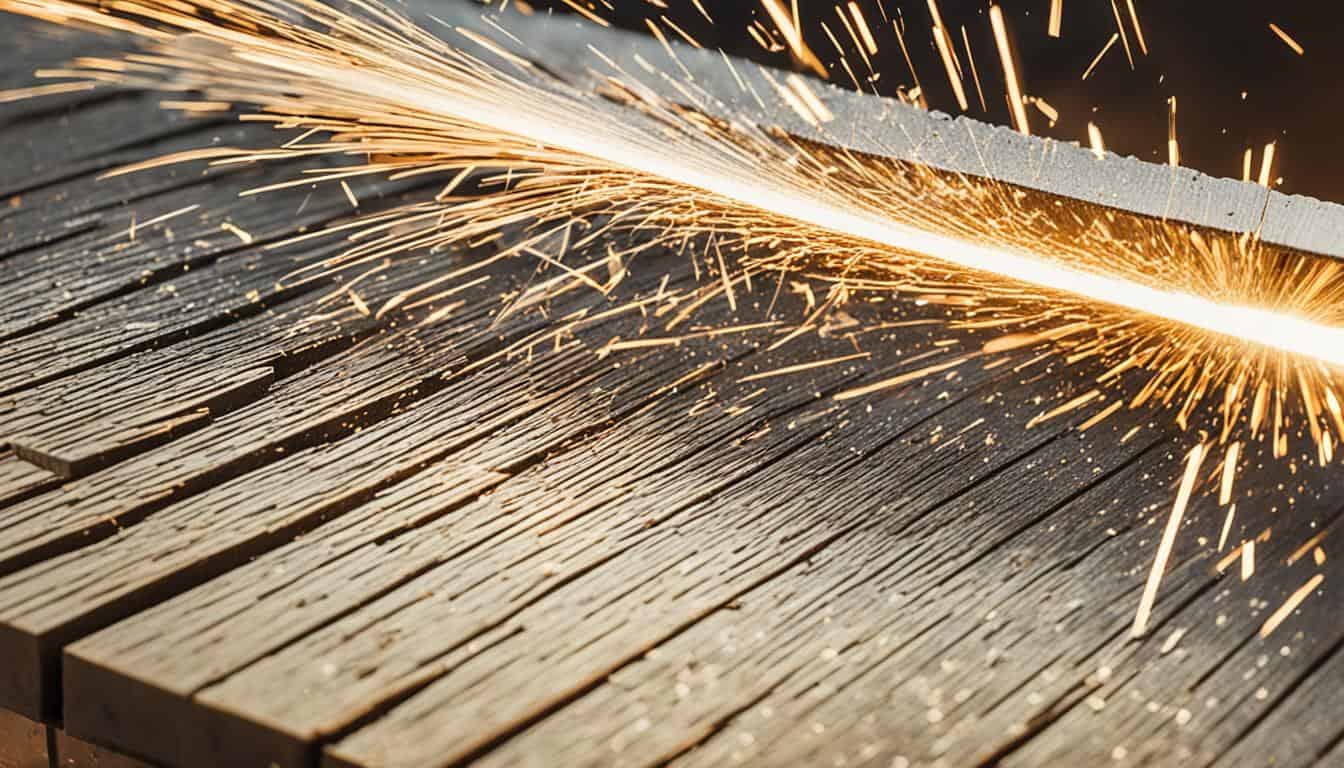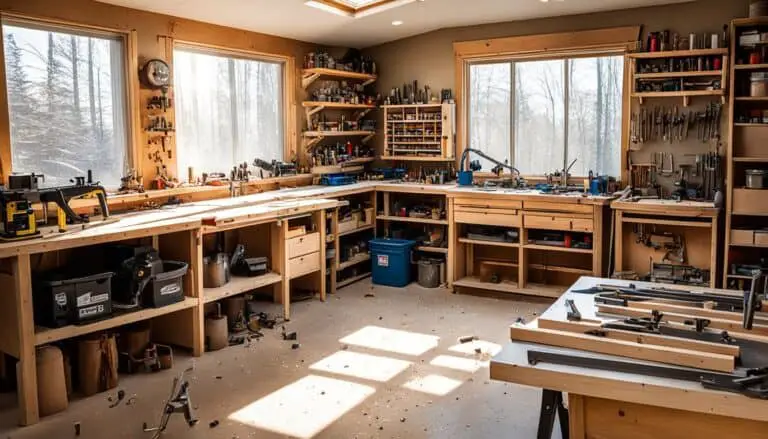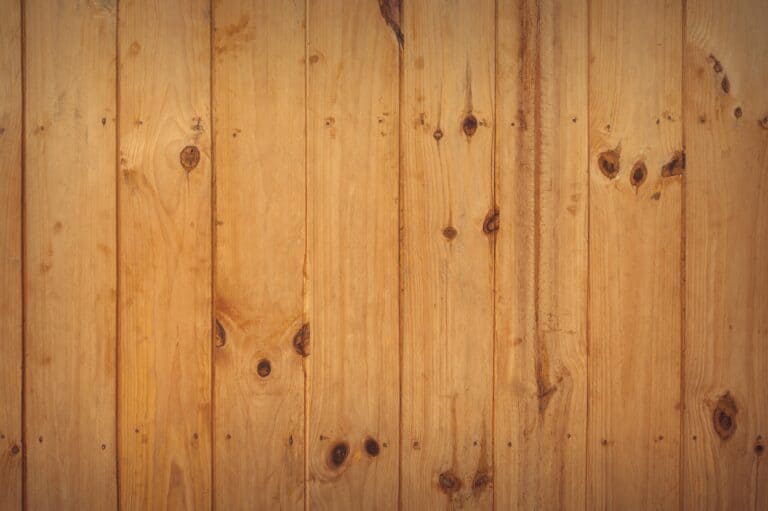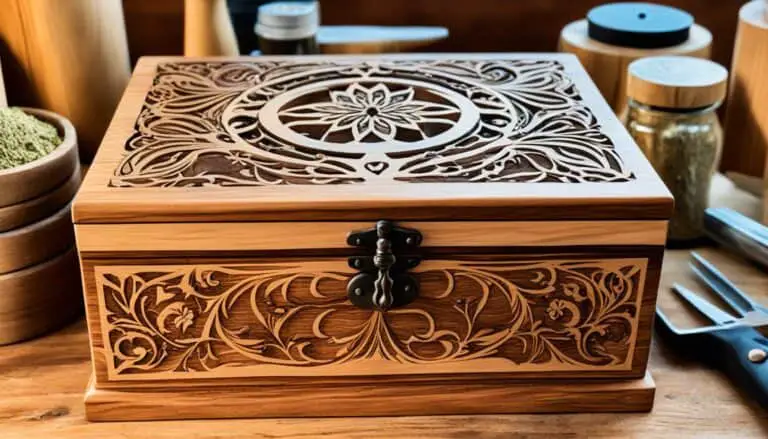A bandsaw is a powerful tool commonly used in woodworking and metalworking projects. However, it can also be dangerous if not used correctly. In this ultimate guide, we will provide you with essential tips for using a bandsaw safely, ensuring that you can master your woodworking or metal projects with confidence.
Key Takeaways:
- Learn the owner’s manual and understand the applications and limitations of your bandsaw.
- Wear appropriate safety equipment, such as safety glasses, hearing protection, and gloves.
- Follow safety procedures, including checking blade condition, tension, and ensuring proper blade tracking.
- Avoid using excessive force, backing the stock away, and unattended operation of the bandsaw.
- Maintain the bandsaw through regular cleaning, lubrication, blade inspection, and overall maintenance.
Preparing for Bandsaw Use
Before using a bandsaw, it is crucial to take necessary precautions to ensure your safety and the efficiency of your woodworking or metalworking projects. By following these essential steps, you can properly prepare for bandsaw use.
Read and Understand the Owner’s Manual
Start by carefully reading the owner’s manual provided with your bandsaw. This manual contains important instructions and guidelines specific to your machine. Understanding these instructions will help you operate the bandsaw safely and effectively.
Familiarize Yourself with Applications and Limitations
Next, familiarize yourself with the applications and limitations of the bandsaw. Knowing what materials and tasks the bandsaw can handle will prevent you from attempting to cut or shape materials beyond its capabilities. Understanding its limitations will also help you identify potential safety hazards.
Securely Anchor the Bandsaw
To reduce vibration and ensure stability during operation, securely anchor the bandsaw to the floor or a workbench. This will provide a solid foundation for the machine and help maintain accurate and controlled cuts.
Refer to General Safety Tips
Additionally, refer to general safety tips for woodworking machines. These guidelines include wearing appropriate personal protective equipment (PPE), inspecting the machine for any damage or defects, and keeping the work area clean and free from clutter. Prioritizing safety precautions will minimize the risk of accidents and injuries.
By taking these preparatory steps, you can create a safe and efficient environment for using the bandsaw. Now that you are well-prepared, let’s move on to the essential safety procedures to follow when operating a bandsaw.
Essential Safety Procedures
When using a bandsaw, it is crucial to prioritize safety by following essential procedures and utilizing the appropriate safety equipment. Here are some important guidelines to ensure a safe and accident-free experience:
1. Safety Equipment
Always wear the necessary safety equipment to protect yourself while operating a bandsaw. This includes safety glasses or goggles to shield your eyes from flying debris, hearing protection to reduce noise exposure, and appropriate footwear for secure footing.
2. Guards
Ensure that all guards on the bandsaw are in place and adjusted correctly. Guards play a vital role in preventing accidental contact with the blade and should never be removed or bypassed.
3. Blade Condition and Tracking
Regularly check the condition of the blade before use. Ensure that it is sharp and free from damage or dullness. Additionally, check the blade tracking to ensure it is correctly aligned on the track. Misaligned blades can lead to poor cutting performance and potential hazards.
4. Blade Tension
Maintain proper blade tension according to the manufacturer’s recommendations. An excessively loose or tight blade can compromise cutting accuracy and increase the risk of blade breakage. Check the tension regularly and adjust as needed.
5. Push Stick
When working with small pieces of material, always use a push stick to guide the stock through the blade. This helps keep your hands safely away from the line of cut and minimizes the risk of accidental contact with the blade.
6. Stock Positioning
Properly position and hold the stock while using a bandsaw. Always keep your hands away from the line of cut and firmly grip the material to prevent it from shifting or rotating during the cutting process. The flat side of the stock should be placed securely against the table for stability.
By following these essential safety procedures, you can minimize the risk of accidents and ensure a safe working environment when using a bandsaw.
What to Avoid
When working with a bandsaw, it is important to be mindful of certain actions to ensure your safety and the effectiveness of your work. By following these precautions, you can avoid unnecessary risks and potential accidents.
1. Avoid Using Excessive Force
Do not exert excessive force when pushing the wood past the blade. Let the bandsaw do the work and apply gentle, controlled pressure to guide the stock. Using excessive force can lead to blade binding, kickbacks, or other dangerous situations.
2. Do Not Back the Stock Away While the Saw is in Motion
If the stock binds or pinches during the cutting process, avoid the temptation to back it away from the blade while the saw is still running. This can result in kickbacks or unintended contact with the blade. Instead, stop the saw, and carefully release the pressure to free the stock.
3. Never Stop the Saw by Thrusting Stock Against the Blade
After shutting off the power, never stop the saw by forcefully thrusting the stock against the cutting edge or the side of the blade. This can cause the stock to jump or kick back, leading to injury. Instead, hold the material firmly and wait for the blade to come to a complete stop before removing the piece.
4. Proper Sawdust Removal
Regularly remove sawdust and cuttings from the bandsaw table and the surrounding area to maintain a clean and safe workspace. Accumulated sawdust can obstruct the blade’s path, affect cutting accuracy, and increase the risk of fire.
5. Avoid Unattended Operation
Never leave a bandsaw running unattended. Always ensure that the machine is properly attended and shut off when not in use. This prevents accidents and ensures that the bandsaw is used safely and responsibly.
By adhering to these bandsaw precautions and avoiding these common pitfalls, you can create a safer and more productive work environment while achieving accurate and precise cuts for your woodworking projects.
Bandsaw Maintenance
Regular maintenance is crucial to ensure the proper functioning and longevity of your bandsaw. By following a routine maintenance schedule, you can keep your machine in optimal condition and enjoy accurate and smooth cutting results. Here are some key maintenance tasks to prioritize:
Cleaning
To maintain the cleanliness of your bandsaw, regularly remove dust, debris, and sawdust buildup. Use a brush or compressed air to clean the blade, guides, wheels, and other parts of the machine. This prevents clogging, ensures smooth operation, and helps extend the life of your bandsaw.
Lubrication
Proper lubrication is essential for the smooth functioning of your bandsaw. Follow the manufacturer’s recommendations for lubricating the blade guides, wheel bearings, and other moving parts. Lubrication reduces friction, minimizes wear and tear, and promotes efficient operation.
Blade Inspection
Regularly inspect the blade for wear, damage, or dullness. A worn or damaged blade can compromise cutting performance and even pose safety risks. If you notice any issues, replace the blade promptly to maintain clean and accurate cuts.
Blade Tracking and Tension
Periodically check the blade tracking and tension to ensure optimal performance. Improper blade tracking can lead to uneven cuts, while inadequate tension may result in blade breakage. Adjust the tracking and tension as necessary to maintain smooth and precise cutting.
Table Alignment
Verify that the table is square to the blade for accurate cuts. Misaligned tables can cause inconsistent and inaccurate cutting results. Adjust the table alignment if needed to ensure the blade tracks properly and provides clean cuts.
Regular Maintenance Schedule
Follow the manufacturer’s recommended maintenance schedule for your bandsaw. This may include replacing worn-out parts, checking the alignment of various components, and performing other necessary tasks to keep your machine in top shape. Adhering to a regular maintenance routine helps maximize the lifespan of your bandsaw and ensures reliable performance.
| Task | Frequency |
|---|---|
| Cleaning | After each use |
| Lubrication | As recommended by the manufacturer |
| Blade Inspection | Regularly and before each use |
| Blade Tracking and Tension | Regularly and before each use |
| Table Alignment | Regularly and as needed |
By prioritizing bandsaw maintenance, you can ensure the longevity and reliability of your machine. Regular cleaning, lubrication, blade inspection, blade tracking and tension checks, and table alignment are essential for optimal performance. Stick to a consistent maintenance schedule and follow the manufacturer’s recommendations to keep your bandsaw operating at its best.
Workspace Preparation
Before using a bandsaw, it is important to properly prepare your workspace to ensure a safe and organized working environment. By following these workspace preparation tips, you can enhance your bandsaw experience and reduce the risk of accidents.
Clear the Work Area
Clear your work area of any materials or objects that could potentially interfere with the operation of the bandsaw. Remove clutter, such as tools, wood scraps, or other items, from the immediate vicinity of the machine. This will provide you with sufficient space to work and reduce the chances of tripping or accidentally knocking over objects while operating the bandsaw.
Clean the Bandsaw Table
Ensure that the bandsaw table is clean and free from any dust, debris, or sawdust buildup. A clean and smooth table surface helps maintain the accuracy of your cuts and prevents any material from getting caught or snagged during operation.
Ensure Proper Lighting
Proper lighting is crucial when working with a bandsaw. Make sure that your workspace is well-lit, allowing you to clearly see the cutting area and ensure accurate and safe cuts. If necessary, add additional lighting sources, such as task lights or overhead lights, to improve visibility and reduce the risk of accidents.
Tip: Consider using LED lights or other energy-efficient lighting options to provide bright and focused illumination for your bandsaw workspace.
Keep the Area Clutter-Free
Maintain a clutter-free work area around your bandsaw to minimize the risk of accidents. Store tools, accessories, and materials in designated storage areas or shelves when not in use. Keeping your workspace organized and free from unnecessary clutter will promote a safe and efficient working environment.
Personal Protective Equipment (PPE)
When using a bandsaw, it is crucial to prioritize your safety with the use of Personal Protective Equipment (PPE). These essential safety gear items help protect you from potential hazards and ensure a safe woodworking experience. Here are the key PPE items to consider:
Safety Glasses or Goggles
Wearing safety glasses or goggles is vital for safeguarding your eyes from flying debris that may result from cutting wood. These protective eyewear options shield your eyes from potential injuries, providing you with peace of mind while operating the bandsaw.
Ear Protection
In the woodworking area, there can be excessive noise levels that may harm your hearing. To guard against noise exposure, it is recommended to wear ear protection, such as earplugs or earmuffs. These accessories help reduce the risk of long-term hearing damage.
Gloves
Using gloves when working with a bandsaw can offer additional hand protection. Choose gloves made of materials that provide a good grip and dexterity. However, be cautious with loose-fitting gloves that may pose a risk of entanglement with the bandsaw blade. It’s important to strike a balance between safety and maneuverability.
Dust Mask or Respirator
Avoid inhaling fine wood particles by wearing a dust mask or respirator. These protective devices filter out particles suspended in the air, preventing potential respiratory issues. Select a mask or respirator that meets the appropriate safety standards and ensures a secure fit for effective protection.
By equipping yourself with the right PPE, including safety glasses or goggles, ear protection, gloves, and a dust mask or respirator, you ensure maximum safety and reduce the risk of accidents while using a bandsaw.
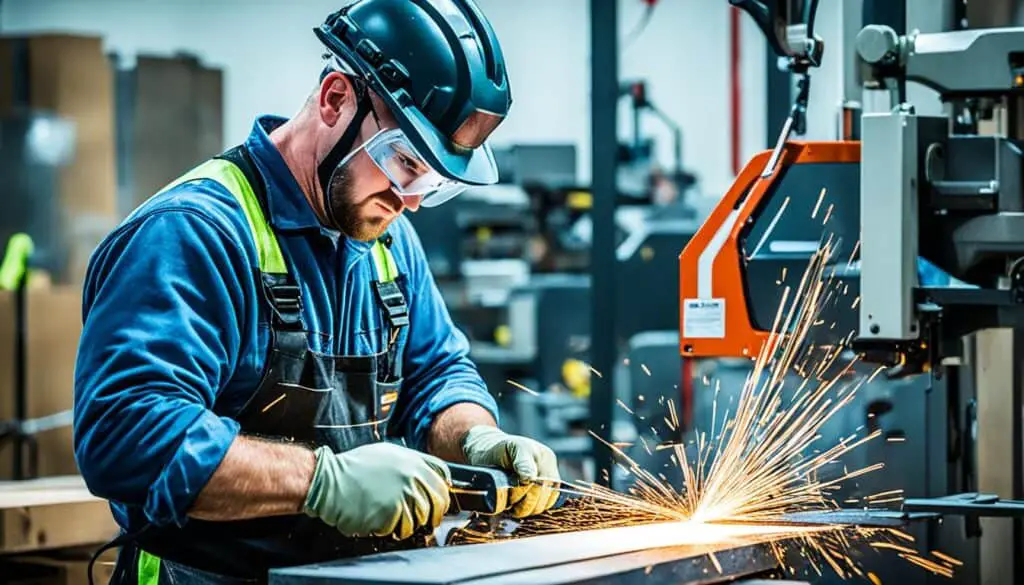
Band Tension and Tracking
Checking the band tension and tracking is crucial for optimal bandsaw performance. Before using the machine, ensure that the blade is properly tensioned according to the manufacturer’s specifications. Proper tension ensures that the blade remains stable during operation, reducing the risk of blade breakage and improving cutting accuracy.
To check the band tension, start by turning off the bandsaw and engaging the tension release lever. This will release the tension on the blade, allowing you to adjust it. Use a tension gauge or follow the manufacturer’s instructions to set the proper tension.
Once the blade is properly tensioned, it’s important to check the blade alignment or tracking. The blade should be aligned in the center of the tire wheels to ensure smooth and accurate cutting. To adjust the tracking, use the bandsaw’s tracking adjustment knob or lever. Make small adjustments and observe the blade’s movement on the tire wheels. The goal is to align the blade so that it runs perfectly centered.
Proper band tension and tracking contribute to the overall performance and longevity of your bandsaw. It allows for cleaner cuts and reduces the risk of accidents. Regularly inspect and adjust the tension and tracking as needed to maintain optimal bandsaw operation.
| Benefits of Proper Band Tension and Tracking | Consequences of Improper Band Tension and Tracking |
|---|---|
|
|
Blade Selection
Choosing the right blade for your bandsaw and specific task is essential. Different blades have varying widths, tooth configurations, and cutting speeds. To ensure optimal cutting performance and reduce strain on the machine, consult the bandsaw’s manual or seek expert advice when selecting the suitable blade for your woodworking or metalworking project.
Blade width:
- A narrower blade is ideal for intricate cuts and tight curves.
- A wider blade provides stability and is suitable for straight cuts or resawing thick stock.
Tooth configuration:
- A finer tooth configuration, such as a high TPI (teeth per inch), is suitable for cutting thin or delicate materials with a smooth finish.
- A coarser tooth configuration, with a lower TPI, is ideal for faster cutting through thicker materials.
Cutting speed:
- For softer materials, a higher cutting speed can be used to achieve clean and efficient cuts.
- Harder materials may require a slower cutting speed to prevent overheating and blade dulling.
H3: Benefits of Choosing the Right Blade
Using the proper blade for your bandsaw ensures:
Optimal cutting performance: The right blade allows for accurate and efficient cuts, reducing the need for excess sanding or finishing.
Extended blade life: Choosing a suitable blade minimizes strain on the machine, increasing the blade’s longevity and reducing the frequency of blade replacements.
Improved safety: Using the appropriate blade enhances control and reduces the risk of kickbacks or blade breakage, promoting a safer working environment.
| Material | Blade Selection |
|---|---|
| Softwood | Narrow blade with high TPI for smooth, clean cuts |
| Hardwood | Wider blade with medium TPI for stability and efficient cutting |
| Metal | Bimetal blade for longevity and resistance to heat |
| Plastic | Fine-toothed blade for precise cuts and minimal chipping |
| Composite Materials | Variable tooth configuration blade for versatility in cutting multiple materials |
Blade Guards and Guides
Blade guards and guides are crucial components of bandsaws that play a significant role in both safety and cutting accuracy. As you operate your bandsaw, it is essential to always keep the blade guards and guides in place. These safety features help prevent accidental contact with the blade, reducing the risk of severe injuries.
The primary purpose of blade guards is to shield you from direct contact with the blade while it’s in motion. By keeping the guards intact, you create a physical barrier that minimizes the chances of accidental hand or finger contact. This is especially important when making intricate or curved cuts, where the risk of an accidental slip or loss of control increases.
In addition to enhancing safety, blade guides also ensure consistent and accurate cuts. These guides help maintain proper blade alignment and prevent blade deflection during the cutting process. By guiding the blade along its intended path, the guides ensure that the material remains properly aligned, resulting in precise cuts with minimal deviation.
Whether you’re working on woodworking or metalworking projects, maintaining the integrity of the blade guards and guides is vital for your safety and the quality of your work. Remember, even experienced professionals adhere to safety protocols and keep these safety features in place at all times.
Having a clear understanding of the importance of blade guards and guides, you can confidently operate your bandsaw, knowing that you’re prioritizing safety and achieving accurate cutting results.
Material Securement
In order to ensure a safe and accident-free cutting process, it is crucial to secure the workpiece properly. By using clamps or a vice, you can hold the material firmly in place, preventing it from shifting or spinning during operation. This not only guarantees a stable and controlled cutting process but also reduces the risk of accidents or injuries.
Securely clamping the workpiece provides stability and allows you to concentrate on the task at hand without worrying about the material moving unexpectedly. Whether you’re working with wood or metal, using clamps or a vice ensures that the workpiece remains securely in position throughout the cutting process.
When selecting clamps or a vice, choose ones that are appropriate for the size and shape of your workpiece. Consider the thickness and weight of the material to determine the type of clamp or vice that will provide the necessary stability. Remember to position the clamps or vice in strategic locations to prevent any shifting during cutting.
By taking the time to properly secure your workpiece before making any cuts, you can minimize the risk of accidents and ensure a smooth and precise cutting experience. Don’t underestimate the importance of material securement, as it plays a crucial role in preventing shifting and maintaining control over the workpiece.
| Benefits of Material Securement | Examples |
|---|---|
| 1. Enhanced safety: Prevents shifting and reduces the risk of accidents. | 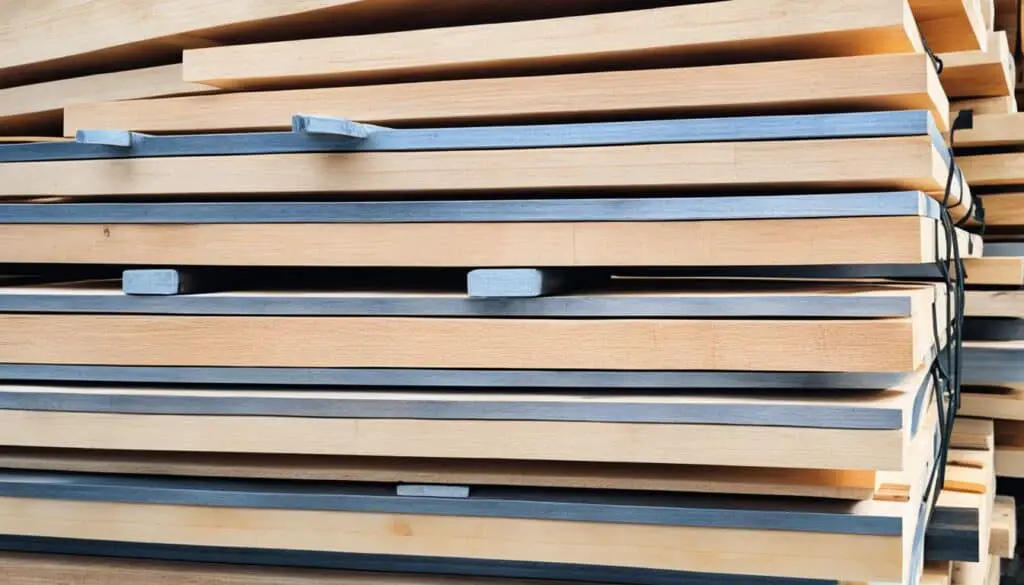 |
| 2. Improved cutting precision: Maintains control over the workpiece for accurate cuts. | |
| 3. Reduced material damage: Minimizes the chances of the workpiece being marred or ruined during cutting. |
Feed Rate and Mindful Operation
When using a bandsaw, it is crucial to maintain a steady and controlled feed rate while pushing the wood into the blade. This ensures smooth and precise cuts, preventing any unnecessary strain on the machine. Avoid using excessive pressure or forcing the material, as it can lead to kickbacks or blade binding, posing a safety hazard. By maintaining a controlled feed, you can prevent accidents and achieve optimal cutting results.
As you operate the bandsaw, it is important to stay attentive and focused on your task. Pay close attention to your hand positioning, ensuring that you keep your fingers at a safe distance from the blade. By practicing attentive operation, you reduce the risk of accidents and injuries.
Remember, your safety is paramount. Always follow recommended safety guidelines and use appropriate personal protective equipment while operating the bandsaw.
Bandsaw Cleaning
Regular cleaning of your bandsaw is crucial for maintaining its performance and preventing sawdust buildup. Proper cleaning techniques can help prolong the lifespan of your machine and ensure smooth operation.
One effective method for bandsaw cleaning is to use a brush to remove dust, debris, and sawdust from various areas, including the blade, guides, wheels, and other parts of the machine. By diligently removing accumulated debris, you can minimize the risk of clogging and maintain optimal performance.
Another useful tool for bandsaw cleaning is compressed air. With its high-pressure airflow, compressed air can effectively dislodge and remove hard-to-reach dust particles, ensuring that your bandsaw operates smoothly.
Remember to clean your bandsaw regularly to prevent the buildup of sawdust and debris that can affect its performance. Incorporating bandsaw cleaning into your routine maintenance will help keep your machine in top shape and ensure accurate, clean cuts.
Lubrication and Blade Inspection
Proper lubrication is crucial for maintaining the smooth operation of your bandsaw. Following the manufacturer’s recommendations, ensure that you regularly lubricate the blade guides, wheel bearings, and other moving parts. This helps reduce friction, enhancing the efficiency of your bandsaw.
In addition to lubrication, it is essential to inspect the blade regularly to ensure optimal performance. Check for any signs of wear, damage, or dullness. A blade in poor condition can compromise the quality of your cuts and put unnecessary strain on the machine. If needed, replace the blade to maintain clean, precise cuts and prolong the lifespan of your bandsaw.
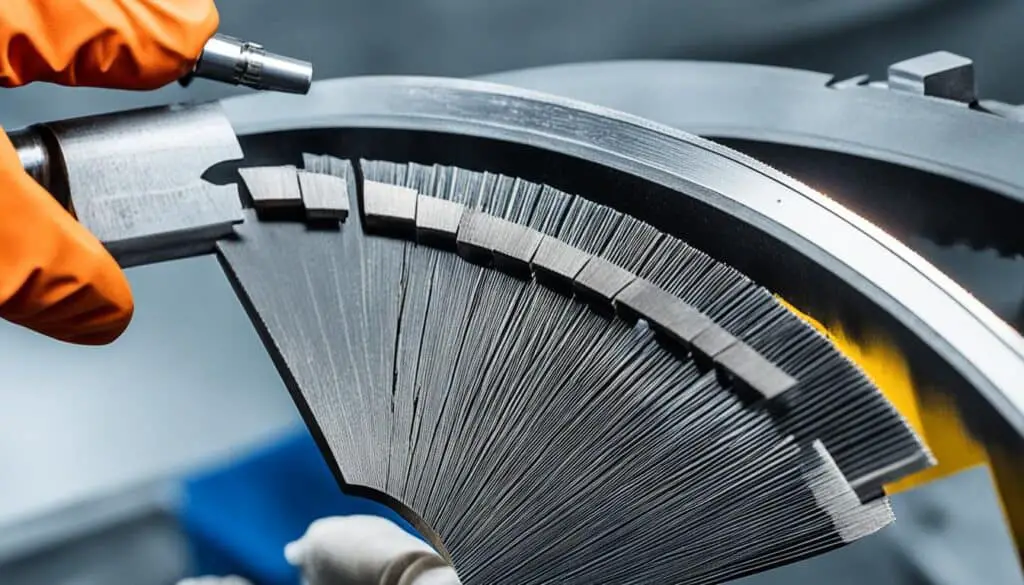
Blade Inspection Checklist:
- Check the blade for any signs of wear, such as missing or damaged teeth.
- Inspect the blade for any visible cracks or chips.
- Ensure the blade is properly aligned and tensioned.
- Verify that the blade is sharp and free from dullness.
- Check for any abnormalities, such as excessive vibration or noise during operation.
Regular inspection and maintenance of your bandsaw blade will help you achieve consistent and precise cuts. By taking the time to lubricate the necessary parts and inspect the blade, you can ensure your bandsaw operates at its best, delivering high-quality results for your woodworking or metalworking projects.
| Benefits of Proper Lubrication and Blade Inspection |
|---|
| 1. Enhanced performance and efficiency of the bandsaw. |
| 2. Prolonged lifespan of the machine. |
| 3. Reduction in friction and wear on moving parts. |
| 4. Consistent and clean cuts in your woodworking or metalworking projects. |
| 5. Minimization of strain and potential damage to the bandsaw. |
Electrical Components and Regular Maintenance
As part of regular maintenance for your bandsaw, it is crucial to inspect the electrical components to ensure safe and efficient operation. Pay close attention to the power cord and switch for any signs of damage, such as frayed wires or loose connections. Damaged electrical components can pose significant electrical hazards, so it’s essential to promptly repair or replace any faulty parts.
Follow the manufacturer’s recommended maintenance schedule for your bandsaw, as it may vary depending on the specific model. Regular maintenance tasks may include replacing worn-out parts, cleaning or replacing filters, and checking the alignment of various components. By following these maintenance guidelines, you can prevent unexpected breakdowns and extend the lifespan of your bandsaw.
Regular inspection and maintenance not only ensure the safety of your bandsaw but also contribute to its overall performance. Well-maintained electrical components promote a stable power supply, reducing the risk of power surges or other electrical issues that could impact the bandsaw’s functionality.
Table: Bandsaw Maintenance Checklist
| Maintenance Task | Frequency |
|---|---|
| Inspect power cord and switch | Monthly |
| Replace worn-out parts | As needed |
| Clean or replace filters | As needed |
| Check alignment of components | Quarterly |
By incorporating regular maintenance into your bandsaw care routine, you can ensure the safe and efficient operation of your machine while maximizing its lifespan.
Conclusion
By following the essential tips and safety measures outlined in this guide, you can confidently use a bandsaw for your woodworking or metalworking projects. Taking the necessary precautions, maintaining the machine, and using appropriate personal protective equipment will help ensure a safe and successful experience with your bandsaw.
Remember to always prioritize safety and adhere to the manufacturer’s instructions and guidelines. Properly prepare for bandsaw use by familiarizing yourself with the owner’s manual, applications, and limitations. Follow essential safety procedures such as wearing safety glasses, using guards, and using a push stick when necessary.
Additionally, be mindful of what to avoid, such as excessive force and unattended operation. Regular maintenance, including cleaning, lubrication, and blade inspection, is crucial for the bandsaw’s longevity and performance. Keep your workspace organized and well-lit, and use personal protective equipment such as safety glasses, hearing protection, and gloves.
By implementing these practices and staying diligent, you can confidently operate your bandsaw, knowing that safety is a top priority. So, happy woodworking!
FAQ
What precautions should I take before using a bandsaw?
Before using a bandsaw, be sure to read the owner’s manual carefully, understand the instructions, and familiarize yourself with the applications and limitations of the machine. Additionally, securely anchor the bandsaw to the floor or workbench and follow general safety tips for woodworking machines.
What are essential safety procedures for using a bandsaw?
When using a bandsaw, it is crucial to wear safety glasses or goggles, hearing protection, and appropriate footwear. Ensure all guards are in place and adjusted properly, and check the condition and positioning of the blade. Maintain proper blade tension, use suitable blades, and keep hands away from the line of cut. Use a push stick when necessary and hold the stock firmly and flat on the table.
What actions should I avoid when working with a bandsaw?
Avoid using excessive force when pushing wood past the blade, and never back the stock away from the blade while the saw is in motion if it binds or pinches. Do not stop a bandsaw by thrusting stock against the cutting edge or the side of the blade immediately after shutting off the power. Additionally, use proper methods to remove sawdust and cuttings from the table and never leave a bandsaw running unattended.
What maintenance should I perform on a bandsaw?
Regular maintenance includes cleaning the machine, lubricating blade guides and moving parts, inspecting the blade for wear or damage, checking blade tracking and tension, ensuring table alignment, and following the manufacturer’s recommended maintenance schedule for replacing worn-out parts and checking component alignment.
How should I prepare my workspace for bandsaw use?
Clear the work area of any materials or objects that could interfere with the operation, clean the bandsaw table, ensure the workspace is well-lit for better visibility, and keep the area free from clutter to maintain a safe and organized working environment.
What personal protective equipment (PPE) should I wear when using a bandsaw?
When using a bandsaw, it is essential to wear safety glasses or goggles, ear protection, gloves for hand protection, and consider wearing a dust mask or respirator to avoid inhaling fine wood particles.
Why is band tension and tracking important in a bandsaw?
Band tension and tracking are crucial for optimal bandsaw performance. Proper tension and alignment of the blade reduce the risk of blade breakage and deviations during operation, ensuring smooth and accurate cutting.
How do I choose the right blade for my bandsaw?
Consult the bandsaw’s manual or seek expert advice to select the appropriate blade for your woodworking or metalworking project. Different blades have varying widths, tooth configurations, and cutting speeds, and using the right blade ensures optimal cutting performance and reduces strain on the machine.
Are blade guards and guides important in bandsaws?
Yes, blade guards and guides are critical safety features in bandsaws. Always keep them in place during operation to prevent accidental contact with the blade. These guards not only enhance safety but also improve cutting accuracy by keeping the material properly aligned during cuts.
How should I secure the workpiece when using a bandsaw?
Use clamps or a vice to hold the workpiece firmly in place, preventing it from shifting or spinning during operation. This ensures a stable and controlled cutting process.
What feed rate should I maintain when using a bandsaw?
Maintain a steady and controlled feed rate when pushing the wood into the blade. Avoid using excessive pressure or forcing the material, as this can lead to kickbacks or blade binding. Stay attentive to hand positioning and maintain a safe distance between your fingers and the blade.
How should I clean my bandsaw?
Regularly clean the bandsaw to prevent sawdust buildup. Use a brush or compressed air to remove dust, debris, and sawdust from the blade, guides, wheels, and other parts of the machine. This helps prevent clogging and ensures smooth operation.
Why is lubrication and blade inspection important for a bandsaw?
Proper lubrication of blade guides, wheel bearings, and other moving parts reduces friction and helps the bandsaw operate efficiently. Additionally, inspecting the blade regularly for signs of wear, damage, or dullness ensures clean cuts and minimizes strain on the machine.
How should I maintain the electrical components of a bandsaw?
Inspect the bandsaw’s electrical components, such as the power cord and switch, for any signs of damage. Promptly repair or replace any faulty parts to prevent electrical hazards. Follow the manufacturer’s recommended maintenance schedule, which may include replacing worn-out parts, cleaning or replacing filters, and checking the alignment of various components.


